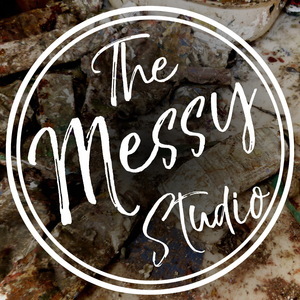Meaning in Abstraction
Episode 86 · August 25th, 2019 · 30 mins 32 secs
About this Episode
Intro: Many of our listeners know about the book that Jerry McLaughlin and I co-wrote--Cold Wax Medium: Techniques, Concepts & Conversation—and also that, from the beginning we did not want to only talk about techniques (hence the title.) Today we want to talk about why we find the concepts and ideas of abstraction important and offer some ideas about understanding and developing meaning in your own work.
In a recent podcast Ross and I talked about the commonalities abstraction has with other approaches to art as well as its unique aspects. We mentioned then that there are challenges for artists working in abstraction and today we’ll talk more about that. How to bring meaning and individuality to the work?
An idea that some find hard to grasp—thinking abstraction is simply design or random occurrences. Yet all you have to do is recognize that people have personal voices and recognizable styles to know that there is more going on than that.
Odd that imagery = meaning for many people. Tied to a strictly literal way of thinking and interpreting. Using only a small part of our means of appreciating the world.
Labeling of imagery can lead to a shallow interpretation of any kind of art including realism—ask more questions, why has the artist chosen the subject matter, how is it handled. True appreciation never stops with identifying subject matter even when it is the most obvious component.
Abstraction—usually imagery is removed from the equation, or if it is there it is handled in a non-illusionistic way. We can jump in more readily to the interesting things—what’s behind the work. Labeling does not need to intrude. Abstraction includes the artist's experiences, emotions, thoughts.
We do accept non-literal associations through our other senses--hearing, smelling, tasting.
Our human brains seek structure and meaning-- but literal image is only one type of structure. Look for how the artist has structured the work as a way in. Notice contrasts, how the visual elements are used and which ones.
As the artist, abstract painting requires abstract thinking. Letting go of labels, letting yourself be carried by ideas, feelings, memories. No need to explain, stay logical. We've all founnd ourselves caught in reveries without visual reference.
At the same time give yourself some structure—identify intentions, preferred elements, use of form and content.
Getting away from linear thinking does NOT mean lack of content. Many things bring meaning to our lives that are not clearly defined.
Sources of abstraction include any aspect of experience you care to bring to your work—in any combination. We can be pulled off track into the familiar when "things" appear as part of the process. this can be very random.
Intuition does not mean finding something identifiable things in the painting but rather playing off important visual elements.
Intentions: important to set them to develop and understand yourself and meaning of your work. Your essential character and core values and feelings. They make your work you. They can evolve over time.
Challenges for Artists /personal voice
Idea that abstract artists as need to be more individualized or unique because they are creating their own realties rather than depicting a shared one as with realism.
BUT like other approaches, there are similar appearances. Ex: geometric abstraction, abstract expressionism.
Learn about artists working in these ways and how your work might be seen in that context, the history and cultural connections among people.
You can feel quite lost without these references. Be open to various influences that mix and enrich your work. Influence doesn't mean it has to have obvious visual siilarities. Can be an intrigue with process, background, thoughts.
What other aspects of your life bring meaning to your work? what are you interested in?
Expressing your complete self is an advantage of abstraction. The multiplicity of influences and sources both external and internal can be very rich. Keep an ongoing awareness of these. This can also include spontaneous, intuitive work.
Involves a lot of personal, inner work--a very examined life. An understanding of yourself.
Intentions involve both personal content and formal aspects (such as exploration of color.)
Be willing to examine your own inner impulses, and for ways to communicate those . be able to think in an abstract way, don't over-explain. Difficult but can look easy to outsiders. Analytic phase interspersed with flow. That takes a lot of experience.
trying to sort all this out may require simplifying, finding a structure, talking about it out loud.
Intuition does play a huge role.
www.rebeccacrowell.com
www.squeegeepress.com
www.facebook.com/messystudiopodcast
